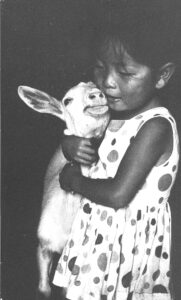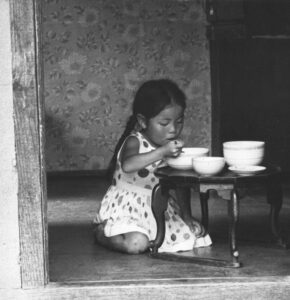By Tess Manjarrez ‘24
South Korea, 1963. Kim In Soon, dressed in a polka-dot dress and recently diagnosed with Hansen’s disease, or leprosy, hugs a young goat. In an era of harsh isolation tactics, Hansen’s was a cruel and lonely disease to catch. While Hansen’s is not a cause of death, it often causes permanent disfigurement and disabilities, which were treated globally as a cause for ostracism. Korean sufferers of the disease were moved from their communities and isolated on Sorok Island, a ‘leper colony’ for those whom society wished to forget. However, children in the early stages of Hansen’s were allowed to stay home on the condition that they were being treated and also not in contact with other children. Six-year-old Kim In Soon was one of these children, as photographed by Lois Dale Whitney.
Whitney, a self-taught photographer and Salem resident, was born in Chicago in 1923 and spent much of her life working in Europe, immortalizing events such as the aftermath of Hungary’s revolution, or the World Health Organization’s outreach in Italy. Whitney’s work in Europe even reached the UN, through the lenses of photo series from Turkey and Germany. In 1963, she took her photojournalism to Wedong Nyun, a village in Southern Korea being visited by a WHO-sponsored mobile leprosy team, and there met the young Kim In Soon, who had just started her first year of school. In a series of photos which capture the playfulness of the young girl as well as the isolation brought on by Hansen’s disease, Whitney’s work deeply humanizes a population made invisible by policy and social stigma.
Isolated as she was from other children, many pieces of Whitney’s photographs from this series feature In Soon engaging alone in otherwise communal activities –– we see her sitting, eating, and playing alone, even as the discolored spots characteristic of Hansen’s begin to appear on her legs and ankles. Whitney was even able to capture the moment in which Dr. Youn Keun Cha informed In Soon’s parents of her diagnosis.
A successful photographer with achievements in both media photography and international photojournalism, Whitney moved to Oregon in 1979, where she remained until her death from cancer in 2003. Her legacy is one rich with stories and kept alive by occasional displays in the Hallie Ford Museum of Art, The Portland Art Museum, Salem Public Library, and Salem Hospital, as well as on the World Health Organization’s own website. Many of her original photographs and associated typed or handwritten context are housed in Willamette University through the Pacific Northwest Artists Archives (PNAA).
While Whitney’s Korean series shows events such as WHO-backed doctors visiting villages or conducting treatments, the truly standout piece in this series is that of Kim In Soon with her goat. By Whitney’s own admittance, the black-and-white photograph is underexposed –– “A great shot”, she writes in her brief notes on the piece, found in the WU archives. “Photo was made inside a barn where we had taken shelter because of rain.” Perhaps the effect was mere happenstance, but its significance remains. The result of the underexposure is a totally black background, a stark contrast to In Soon’s bright dress and white goat. The goat itself seems to be smiling at the camera as In Soon cradles its head, a point of joy in an otherwise lonely future. Truly, with the dark background intent on swallowing them up, it seems in this photograph that Kim In Soon and her goat are alone in the world.
Such images beg the question: what, then, happened to Kim In Soon? Was she, like many victims of Hansen’s, sent to live on Sorok Island? Did she become permanently scarred, and ostracized as a result? Well, no. While Whitney did not add these details in her photograph description, the World Health Organization did indeed check in. Hansen’s disease is treatable, after all, as long as it is caught early. Kim In Soon needed only to continue taking her sulfone tablets regularly for more than a year. She recovered well and was able to continue her education, with the “arrested”, or inactive, lesions on her legs the only reminder of her illness.
The practice of sending those with Hansen’s disease to Sorok Island was officially abolished in 1963, the year Whitney met Kim In Soon, but of course, unofficial abandonment or isolation of ‘lepers’ continued. Indeed, it was not until 2007 that a bridge opened from Sorok Island to the mainland, finally connecting the historically isolated island and its residents to the rest of the country. Decades later, Lois Dale Whitney’s adventures, her notes, and the lives she captured on her 35mm negatives, remain immortalized and frozen in time — much like six-year-old Kim In Soon’s soft smile and the moment she shared with her young goat companion.
*Photograph 07 W.U., 1963, Subseries A, Box: 3, Folder: 7. Dale Whitney papers, WUA017. Willamette University Archives and Special Collections.


